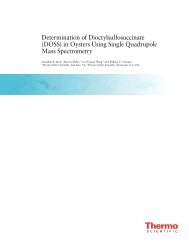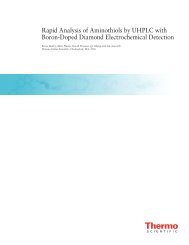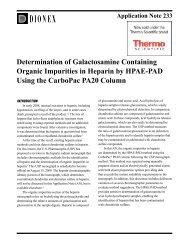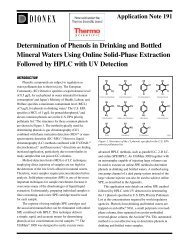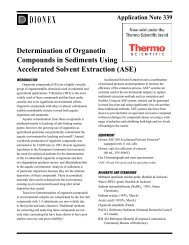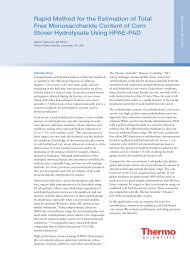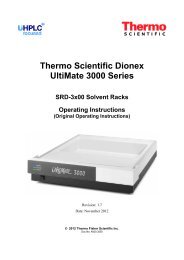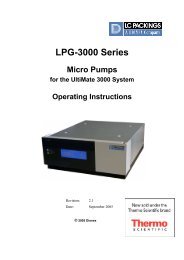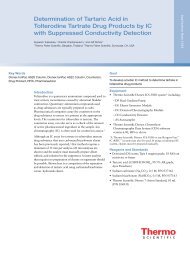Determination of Chlorite, Bromate, Bromide, and Chlorate ... - Dionex
Determination of Chlorite, Bromate, Bromide, and Chlorate ... - Dionex
Determination of Chlorite, Bromate, Bromide, and Chlorate ... - Dionex
Create successful ePaper yourself
Turn your PDF publications into a flip-book with our unique Google optimized e-Paper software.
<strong>Determination</strong> <strong>of</strong> <strong>Chlorite</strong>, <strong>Bromate</strong>,<br />
<strong>Bromide</strong>, <strong>and</strong> <strong>Chlorate</strong> in Drinking Water<br />
by Ion Chromatography with an<br />
On-Line-Generated Postcolumn Reagent<br />
for Sub-µg/L <strong>Bromate</strong> Analysis<br />
Dave Thomas <strong>and</strong> Jeff Rohrer<br />
Thermo Fisher Scientific, Sunnyvale, CA, USA<br />
Introduction<br />
Public water suppliers treat drinking water with disinfectants<br />
to protect public health <strong>and</strong> give drinking water a<br />
pleasant taste <strong>and</strong> odor. Unfortunately, some <strong>of</strong> the<br />
chemical disinfectants or byproducts <strong>of</strong> the disinfection<br />
process are themselves harmful. For example, chlorine<br />
dioxide generates the inorganic oxyhalide disinfection<br />
byproducts (DBPs) chlorite <strong>and</strong> chlorate; hypochlorite<br />
treatment may also generate the DBP chlorate; 1 <strong>and</strong><br />
ozonating source water that contains elevated levels <strong>of</strong><br />
natural bromide can produce the DBP bromate. 2 Both the<br />
World Health Organization (WHO) <strong>and</strong> the U.S. Environmental<br />
Protection Agency (EPA) have listed bromate as a<br />
potential carcinogen at the low-µg/L level. 3<br />
The EPA Stage 1 Disinfectants/Disinfection Byproducts<br />
(D/DBP) Rule specifies a maximum contaminant level<br />
(MCL) <strong>of</strong> 10 µg/L for bromate, an MCL <strong>of</strong> 1000 µg /L 4<br />
for chlorite, <strong>and</strong> prescribes EPA Method 300.1 5 for<br />
compliance monitoring <strong>of</strong> bromate <strong>and</strong> chlorite in<br />
drinking water. It is expected that when the EPA promulgates<br />
Stage 2 <strong>of</strong> the D/DBP Rule, the MCL for bromate<br />
will remain at 10 µg /L <strong>and</strong> the EPA will propose additional<br />
methods for compliance monitoring to add<br />
flexibility <strong>and</strong> improved performance. Until then, the EPA<br />
is evaluating new methods with improved performance<br />
for D/DBP monitoring, including EPA Method 317.0<br />
(IC-PCR, <strong>Dionex</strong> [now part <strong>of</strong> Thermo Scientific]<br />
Application Note [AN] 136), EPA Method 321.8<br />
(IC/ICP-MS), <strong>and</strong> EPA Method 326.0 (IC-PCR). 6–8<br />
This application note describes an improved ion chromatography<br />
(IC) method to quantify oxyhalide DBP anions<br />
<strong>and</strong> bromide at low concentration levels in reagent water,<br />
bottled water, <strong>and</strong> finished drinking water using an<br />
approach that is technically equivalent to U.S. EPA<br />
Method 326.0. The oxyhalide anions chlorite, chlorate,<br />
bromide, <strong>and</strong> bromate are separated on a Thermo<br />
Scientific <strong>Dionex</strong> IonPac AS9-HC column <strong>and</strong><br />
measured by using suppressed conductivity detection (as<br />
in EPA Method 300.1), followed by postcolumn reaction<br />
(PCR) to enhance detection <strong>of</strong> bromate. Sensitivity for<br />
bromate is improved by more than a factor <strong>of</strong> 10 through<br />
the use <strong>of</strong> a postcolumn reaction in which hydroiodic acid<br />
(HI) generated in situ from potassium iodide (KI) reacts<br />
with bromate in the column effluent to form the triiodide<br />
– 9<br />
anion (I ) as shown in the following set <strong>of</strong> reactions: 3<br />
– – + –<br />
BrO + 3I + 3H ↔ 3HOI + Br 3<br />
3HOI + 3I – + 3H + ↔ 3I 2 + 3H 2 O<br />
3I + 3I 2 – – ↔ 3I3 Triiodide is then detected by its strong absorbance at<br />
352 nm.<br />
Because the HI PCR reagent is generated on-line <strong>and</strong> used<br />
immediately, reagent purity <strong>and</strong> stability should be more<br />
easily ensured than in EPA Method 317.0. It is also<br />
advantageous from a safety <strong>and</strong> exposures st<strong>and</strong>point to<br />
use the in situ generated HI versus the toxic o-dianisidine<br />
(ODA) PCR reagent employed in Method 317.0.<br />
EPA Method 326.0 allows for the determination <strong>of</strong> all<br />
three key oxyhalide anions <strong>and</strong> bromide at low-µg/L levels<br />
using conductivity detection. <strong>Bromate</strong> can be quantified<br />
down to 0.5 µg /L using PCR with UV absorbance<br />
detection. Although Method 326.0 is not yet promulgated<br />
by the U.S. EPA Office <strong>of</strong> Ground Water <strong>and</strong> Drinking<br />
Water, the conductivity portion <strong>of</strong> the method has been<br />
determined acceptable for compliance monitoring for the<br />
oxyhalide DBPs <strong>and</strong> bromide.<br />
Application Note 149
2 Equipment<br />
• Thermo Scientific <strong>Dionex</strong> DX-600 Ion Chromatographic<br />
System:<br />
– GP50 Gradient Pump with vacuum degas option<br />
– ED50A Conductivity Detector with AS50<br />
Conductivity Cell (P/N 55400)<br />
– AD25 UV/Vis Absorbance Detector with 10 mm cell<br />
– Thermo Scientific <strong>Dionex</strong> AS50 Automated<br />
Sampler with thermal compartment<br />
– PC10 Pneumatic Postcolumn Delivery module<br />
(P/N 50601)<br />
– Thermo Scientific <strong>Dionex</strong> AMMS 300<br />
Anion MicroMembrane Suppressor<br />
• PCH-2 Reaction Heater (P/N 39348)<br />
• Knitted Reaction Coil, 500 µ L, Potted (for PCH-2)<br />
(P/N 39349)<br />
• Two 4 L plastic bottle assemblies (for external water<br />
mode suppression)<br />
• Thermo Scientifiic <strong>Dionex</strong> Chromeleon Chromatography Workstation<br />
Reagents <strong>and</strong> St<strong>and</strong>ards<br />
• Deionized water (DI), Type I reagent grade, 18 MΩ-cm<br />
resistivity or better<br />
• 0.5 M sodium carbonate (Na CO ) anion eluent<br />
2 3<br />
concentrate (P/N 37162)<br />
• Potassium iodide (KI) (Sigma P-8256) or (Fisher P-410)<br />
• Ammonium molybdate tetrahydrate<br />
[(NH ) Mo O •4H O] (Aldrich 22,136-6)<br />
4 6 7 24 2<br />
• Iron (II) sulfate heptahydrate (FeSO •7H O)<br />
4 2<br />
(Aldrich 21,542-2)<br />
• Ethylenediamine (EDA) (Alfa Products 11932)<br />
• Dichloroacetic acid (DCAA) (Fluka 35810)<br />
• Sulfuric acid, (18M) (J.T. Baker ® Instra-Analyzed ®<br />
9673-33)<br />
• Nitric acid, (70%) (J.T. Baker Instra-Analyzed 9598-00)<br />
• <strong>Bromate</strong> st<strong>and</strong>ard, 1000 mg/L, NaBrO in H O (SPEX<br />
3 2<br />
CertiPrep ® AS-BRO39-2Y)<br />
• <strong>Bromide</strong> st<strong>and</strong>ard, 1000 mg/L, NaBr in H O (ULTRA<br />
2<br />
Scientific ICC-001)<br />
• <strong>Chlorate</strong> st<strong>and</strong>ard, 1000 mg/L, NaClO in H O (SPEX<br />
3 2<br />
CertiPrep AS-CLO39-2Y)<br />
• <strong>Chlorite</strong> st<strong>and</strong>ard, 1000 mg/L, NaClO in H O (SPEX<br />
2 2<br />
CertiPrep AS-CLO29-2Y)<br />
• Sodium bromide (NaBr) (Aldrich 31,050-6)<br />
• Sodium bromate (NaBrO ) (EM SX 03785-1)<br />
3<br />
• Sodium chlorate (NaClO ) (Fluka 71370)<br />
3<br />
• Sodium chlorite (NaClO ) (Fluka 71388, ~80% pure)<br />
2<br />
Conditions<br />
Columns: <strong>Dionex</strong> IonPac AG9-HC, 50 × 4 mm i.d.,<br />
Guard (P/N 51791)<br />
<strong>Dionex</strong> IonPac AS9-HC, 250 × 4 mm i.d.,<br />
Analytical (P/N 51786)<br />
Eluent: 9.0 mM sodium carbonate (Na CO ) 2 3<br />
Flow Rate: 1.3 mL/min<br />
Temperature: 30 °C<br />
Sample Volume: 225 µL<br />
Detection: Suppressed conductivity,<br />
Thermo Scientific <strong>Dionex</strong> Anion Atlas Electrolytic Suppressor (P/N 056116),<br />
auto-suppression, external water mode,<br />
78 mA<br />
Temperature compensation, 1.7%/°C<br />
Expected Background: ~23–26 µS<br />
Expected Backpressure: ~2400 psi<br />
Run Time: 20 min<br />
PCR Conditions<br />
Detection: Absorbance at 352 nm<br />
PCR Reagent Flow: 0.26 M potassium iodide at 0.4 mL/min<br />
AMMS III: 0.3 N sulfuric acid at 2.5 mL/min<br />
Postcolumn<br />
Heater Temp: 80 °C<br />
Preparation <strong>of</strong> Solutions <strong>and</strong> Reagents<br />
Reagent Water<br />
Distilled or DI water 18 MΩ-cm or better, free <strong>of</strong> the<br />
anions <strong>of</strong> interest, <strong>and</strong> filtered through a 0.2 micron filter.<br />
Eluent Solution (9 mM Sodium Carbonate)<br />
Dilute 36 mL <strong>of</strong> 0.5 M sodium carbonate concentrate to<br />
2 L with DI water. Unless the in-line degas option is being<br />
used, sparge eluent prior to use with helium or sonicate<br />
under vacuum for 10 min.<br />
Ethylenediamine (EDA) Preservative Solution<br />
Dilute 2.8 mL <strong>of</strong> ethylenediamine (99%) to 25 mL with<br />
reagent water. Prepare the solution fresh monthly.<br />
Ferrous Iron Solution [1000 mg/L Fe (II)]<br />
Add 0.124 g <strong>of</strong> ferrous sulfate heptahydrate<br />
(FeSO 4 •7H 2 O) to about 15 mL <strong>of</strong> reagent water containing<br />
6 µL concentrated nitric acid in a 25 mL volumetric<br />
flask. Dissolve <strong>and</strong> bring to volume with reagent water<br />
(final pH ~2). Prepare fresh every two days.<br />
Sulfuric Acid Solution (0.5 N)<br />
Dilute 1.4 mL <strong>of</strong> concentrated sulfuric acid to 100 mL<br />
with reagent water.<br />
Ammonium Molybdate Solution (2.0 mM)<br />
Add 0.247 g <strong>of</strong> ammonium molybdate tetrahydrate<br />
[(NH 4 ) 6 Mo 7 O 24 •4H 2 O)] to about 50 mL <strong>of</strong> reagent water<br />
in a 100 mL volumetric flask. Dissolve <strong>and</strong> bring to<br />
volume with reagent water. Store in an opaque plastic<br />
bottle <strong>and</strong> prepare fresh monthly.
Postcolumn Reagent<br />
Add 43.1 g <strong>of</strong> potassium iodide to about 500 mL <strong>of</strong><br />
reagent water in a 1 L volumetric flask <strong>and</strong> mix to<br />
dissolve. Add 215 µL µ<strong>of</strong> the ammonium molybdate<br />
solution. Bring to volume with reagent water <strong>and</strong> mix.<br />
Remove dissolved gasses by sparging with helium or by<br />
sonicating under vacuum for 20 min. Immediately place it<br />
in the PC10 reagent delivery vessel <strong>and</strong> blanket with<br />
helium. Protect from light by covering the PC10 module<br />
with aluminum foil. The reagent is stable for 24 h under<br />
these conditions.<br />
Stock St<strong>and</strong>ard Solutions<br />
Purchase certified solutions or prepare stock st<strong>and</strong>ard<br />
solutions by dissolving the corresponding mass <strong>of</strong> the salt<br />
for each <strong>of</strong> the anions <strong>of</strong> interest (see Table 1) in DI water<br />
<strong>and</strong> dilute to 100 mL.<br />
Table 1. Masses <strong>of</strong> compounds used to prepare 100 mL <strong>of</strong> 1000-mg/L<br />
anion st<strong>and</strong>ards.<br />
Anion Compound Mass (g)<br />
– BrO3 Sodium bromate (NaBrO3 ) 0.1180<br />
Br – Sodium bromide (NaBr) 0.1288<br />
– ClO3 Sodium chlorate (NaClO3 ) 0.1275<br />
– ClO2 Sodium chlorite (NaClO2 ) 0.1344*<br />
* Mass <strong>of</strong> pure (>99%) sodium chlorite. For accurate results, determine the exact purity<br />
<strong>of</strong> NaClO by using the iodometric titration procedure 2 14 <strong>and</strong> adjust the mass <strong>of</strong> the<br />
compound used accordingly. For example, for technical-grade sodium chlorite<br />
(80% pure) use (0.1344 g) (100%/80%) = 0.1680 g.<br />
Prepare a mixed anion calibration stock st<strong>and</strong>ard at<br />
20 mg/L by combining 2 mL each <strong>of</strong> the bromide, chlorite,<br />
<strong>and</strong> chlorate stock st<strong>and</strong>ards in a 100 mL volumetric<br />
flask. Mix <strong>and</strong> bring to volume with reagent water. These<br />
st<strong>and</strong>ards are stable for at least one month when stored at<br />
less than 6 °C.<br />
Because bromate decomposes in the presence <strong>of</strong> chlorite,<br />
prepare a bromate-only calibration stock st<strong>and</strong>ard at<br />
5 mg/L by adding 0.5 mL <strong>of</strong> the bromate stock st<strong>and</strong>ard<br />
to a 100 mL volumetric flask <strong>and</strong> bringing to volume with<br />
reagent water. This st<strong>and</strong>ard is stable for two weeks when<br />
stored at less than 6 °C.<br />
Working St<strong>and</strong>ard Solutions<br />
Use DI water to prepare appropriate dilutions <strong>of</strong> the<br />
calibration stock st<strong>and</strong>ards as needed. Prepare mixed<br />
calibration st<strong>and</strong>ards containing all four anions fresh each<br />
day as needed.<br />
Sample Preparation<br />
Sparge the water samples taken from a treatment plant<br />
employing chlorine dioxide or ozone with an inert gas<br />
(for example, nitrogen, argon, or helium) for 5 min. Add<br />
1.00 mL <strong>of</strong> EDA preservation solution per 1 L <strong>of</strong> sample<br />
to prevent conversion <strong>of</strong> residual hypochlorite or hypobromite<br />
to chlorate or bromate. This solution also<br />
prevents metal-catalyzed conversion <strong>of</strong> chlorite to<br />
chlorate. Samples preserved in this manner are stable for<br />
at least 14 days when stored in amber bottles at 4 °C. 10<br />
Most samples preserved as above can be filtered through a<br />
0.45-micron filter (Gelman IC Acrodisc ® , Pall Corporation,<br />
Port Washington, NY, USA, P/N 4485 or equivalent)<br />
<strong>and</strong> directly injected onto the ion chromatograph.<br />
However, each sample that contains excess chlorite must<br />
be treated to remove chlorite <strong>and</strong> then reanalyzed for<br />
bromate, because elevated levels <strong>of</strong> chlorite can interfere<br />
with the bromate quantification by PCR.<br />
The treatment procedure to remove chlorite requires two<br />
portions <strong>of</strong> the water sample. Place one 10 mL aliquot<br />
<strong>of</strong> the sample into a 20 mL microbeaker. Place a second<br />
10 mL aliquot into a second 20 mL beaker. Fortify one<br />
aliquot <strong>of</strong> the sample with bromate at a level approximating<br />
the native concentration <strong>of</strong> bromate in the untreated<br />
sample. This laboratory-fortified matrix (LFM) will<br />
indicate correct performance <strong>of</strong> the chlorite removal step.<br />
Acidify both aliquots with 33 µL <strong>of</strong> 0.5 N sulfuric acid<br />
solution <strong>and</strong> confirm the final pH (5–6) with pH test<br />
strips. Add 40 µL <strong>of</strong> ferrous iron solution, mix, <strong>and</strong> allow<br />
to react for 10 min. Filter the treated samples through a<br />
0.45 micron nylon filter to remove precipitated ferric<br />
hydroxide. Then pass the solution through a hydroniumform,<br />
cation-exchange cartridge (Thermo Scientific <br />
<strong>Dionex</strong> OnGuard H, P/N 39596) to remove excess<br />
soluble iron. The treated samples must be analyzed within<br />
30 h. 11<br />
System Preparation <strong>and</strong> Setup<br />
Configure the IC with the <strong>Dionex</strong> IonPac AG9/AS9-HC<br />
columns <strong>and</strong> PCR system as depicted in Figure 1 <strong>and</strong> as<br />
described in the PC10 postcolumn delivery system<br />
installation instructions. Verify that the pump flow rate is<br />
within specifications <strong>and</strong> recalibrate if necessary. A GP50<br />
pump should deliver water at 1.0 ± 0.005 mL/min against<br />
a constant backpressure <strong>of</strong> 2000 psi. Verify that the UV<br />
absorbance detector wavelength accuracy is within<br />
specifications. Recalibrate if necessary. It is good practice<br />
to periodically record the visible lamp output (that is, the<br />
reference cell current in nA) <strong>and</strong> elapsed time to assist in<br />
potential troubleshooting. Consult the pump <strong>and</strong> detector<br />
manuals for procedural details.<br />
Install a 1 mL sample syringe <strong>and</strong> set the AS50 syringe<br />
speed to 4 or 5 to make fast large-loop injections. Install<br />
a calibrated 225 µL sample loop made from 111 cm <strong>of</strong><br />
0.02 in. i.d. PEEK (Victrex plc, Thornton Cleveleys,<br />
Lancashire, Engl<strong>and</strong>) tubing. Enter the correct sample<br />
loop size <strong>and</strong> sample syringe volume in the AS50 Plumbing<br />
Configuration screen.<br />
Prepare the <strong>Dionex</strong> Anion Atlas Electrolytic Suppressor<br />
for use by hydrating the eluent chamber. Use a disposable<br />
plastic syringe to slowly push approximately 3 mL <strong>of</strong> DI<br />
water through both the Eluent In port <strong>and</strong> Regen In port.<br />
Allow the suppressor to sit for approximately 20 min to<br />
fully hydrate the suppressor monodisks <strong>and</strong> membranes.<br />
3
4<br />
Eluent<br />
Autosampler<br />
Sample Loop<br />
DX-600 AG9-HC AS9-HC<br />
PC10 PCR<br />
Reservoir<br />
Figure 1. IC system configuration for EPA Method 326.0.<br />
AMMS III<br />
Suppressor<br />
Because the effluent from the conductivity detector cell<br />
will undergo a postcolumn reaction, install the <strong>Dionex</strong><br />
Anion Atlas Electrolytic Suppressor in the external water<br />
mode by following the Installation Instructions <strong>and</strong><br />
Troubleshooting Guide for the Anion Atlas Electrolytic<br />
Suppressor (Document No. 031770). Make sure that the<br />
pressure downstream from the Anion <strong>Dionex</strong> Atlas<br />
Electrolytic Suppressor does not exceed the recommended<br />
operating pressure <strong>of</strong> 20–100 psi. Use 0.02 in. i.d. PEEK<br />
tubing from the <strong>Dionex</strong> Anion Atlas Electrolytic Suppressor<br />
to the mixing tee, to the PCR coil, to the absorbance<br />
detector, <strong>and</strong> to waste, <strong>and</strong> keep it as short as is practical<br />
to minimize backpressure. Adjust the head pressure on<br />
the external water reservoir to deliver a flow rate <strong>of</strong><br />
5–10 mL/min (~10–15 psi). Use a current <strong>of</strong> 78 mA.<br />
Prepare the <strong>Dionex</strong> AMMS 300 suppressor (P/N 56750)<br />
for use by hydrating the eluent chamber. Use a disposable<br />
plastic syringe to slowly push approximately 3 mL <strong>of</strong><br />
0.2 N sulfuric acid through the Eluent Out port <strong>and</strong><br />
5 mL <strong>of</strong> 0.2 N sulfuric acid through the Regen In port.<br />
Allow the suppressor to sit for approximately 20 min to<br />
fully hydrate the suppressor screens <strong>and</strong> membranes.<br />
Install the <strong>Dionex</strong> AMMS 300 suppressor in the chemical<br />
regeneration mode by following the Installation Instructions<br />
<strong>and</strong> Troubleshooting Guide for the Anion<br />
Micromembrane Suppressor (Document No. 031727).<br />
Adjust the head pressure on the 0.3 N sulfuric acid<br />
reservoir to deliver a flow rate <strong>of</strong> 2–3 mL/min (~10–15 psi<br />
if a short piece <strong>of</strong> 0.01 in. i.d. PEEK tubing is connected<br />
to the <strong>Dionex</strong> AMMS 300 suppressor Regen Out port <strong>and</strong><br />
trimmed accordingly).<br />
Pump the eluent at 1.3 mL/min <strong>and</strong> set the PC10 pneumatic<br />
pressure to 70 psi. To measure the PCR flow rate,<br />
collect the effluent from the detector (that is, the total flow<br />
from the IC pump <strong>and</strong> PCR module) in a 10 mL graduated<br />
cylinder for 5 min. The PCR flow rate is the<br />
difference between the total flow rate <strong>and</strong> that <strong>of</strong> the IC<br />
pump. Adjust the air pressure <strong>of</strong> the PC10 postcolumn<br />
Mixing<br />
Tee<br />
UV Absorbance<br />
Detector<br />
Knitted RX Coil<br />
PCH-2 Heater at 80 C<br />
Atlas<br />
Suppressor<br />
Conductivity<br />
Detector<br />
Effluent to waste<br />
15691-01<br />
delivery module <strong>and</strong> remeasure the flow rate until the<br />
correct PCR flow rate <strong>of</strong> 0.4 mL/min is established.<br />
Variations in the PCR flow rate affect the postcolumn<br />
reaction time, pH, dilution, mixing rate, <strong>and</strong> ratio <strong>of</strong> the<br />
reactants. Stable day-to-day results depend on a well<br />
controlled PCR flow rate. Confirm this flow rate on a<br />
daily basis <strong>and</strong> whenever detector response for a calibration<br />
check st<strong>and</strong>ard deviates beyond quality control<br />
acceptance criteria.<br />
The storage solution 10 mM NaHCO 3 is shipped with the<br />
<strong>Dionex</strong> IonPac AS9-HC. After equilibrating the column<br />
with 9.0 mM carbonate eluent for 20 min, analyze a<br />
system blank <strong>of</strong> reagent water. An equilibrated system has<br />
a background conductance ~26 µs, with the peak-to-peak<br />
noise typically 1–2 nS per min. The background absorbance<br />
at 352 nm should be less than 200 mAU with peak<br />
to-peak noise <strong>of</strong> less than 50 µAU per min. There should<br />
be no peaks eluting within the retention time window <strong>of</strong><br />
the bromate anion. The column is equilibrated when two<br />
consecutive injections <strong>of</strong> a st<strong>and</strong>ard produce the same<br />
retention time for bromate.<br />
Results <strong>and</strong> Discussion<br />
Figure 2 shows the chromatograms <strong>of</strong> a mixed anion<br />
st<strong>and</strong>ard containing 5 µg/L each <strong>of</strong> chlorite, bromate,<br />
bromide, <strong>and</strong> chlorate. The top trace (A) was obtained<br />
with the conductivity detector <strong>and</strong> the bottom trace (B)<br />
was obtained with the UV/Vis absorbance detector after<br />
postcolumn reaction with acidified KI. The bromate peak<br />
is baseline resolved from chlorite on both detector<br />
channels. However, the response on the absorbance<br />
detector after PCR with acidified KI is significantly<br />
enhanced compared to the response obtained on the<br />
conductivity detector.<br />
Table 2 summarizes the calibration data <strong>and</strong> method<br />
detection limits (MDLs) obtained for the oxyhalide DBP<br />
anions <strong>and</strong> bromide using dual conductivity <strong>and</strong> UV<br />
detection. The MDL for each analyte was established by<br />
making eight replicate injections <strong>of</strong> a reagent water blank
Column: <strong>Dionex</strong> IonPac AG9-HC, AS9-HC<br />
Eluent: 9.0 mM sodium carbonate<br />
Temp: 30 °C<br />
Flow Rate: 1.3 mL/min<br />
Inj. Volume: 225 µL<br />
Detection: A. Suppressed conductivity,<br />
<strong>Dionex</strong> Anion Atlas Electrolytic Suppressor,<br />
external water mode<br />
B. Absorbance, 352 nm<br />
Postcolumn Reagent: Acidified KI<br />
PCR Flow Rate: 0.4 mL/min<br />
Postcolumn Heater: 80 °C<br />
Peaks A: 1. <strong>Chlorite</strong> 5 µg/L (ppb)<br />
2. <strong>Bromate</strong><br />
3. DCA*<br />
5<br />
4. <strong>Bromide</strong> 5<br />
5. <strong>Chlorate</strong> 5<br />
Peak B: 6. <strong>Bromate</strong>-UV<br />
* DCA = Dichloroacetate quality control surrogate<br />
26.65<br />
A<br />
3<br />
µS<br />
26.40<br />
0.006<br />
AU<br />
B<br />
1 2<br />
6<br />
-0.002<br />
0 5 10 15<br />
20<br />
Minutes<br />
18136-01<br />
Figure 2. Separation <strong>of</strong> a low-ppb inorganic anion st<strong>and</strong>ard using a <strong>Dionex</strong><br />
IonPac AS9-HC column; (A) suppressed conductivity detection <strong>and</strong> (B) UV<br />
absorbance detection after PCR with acidified KI.<br />
4 5<br />
fortified at a concentration <strong>of</strong> 3–5 times the estimated<br />
instrument detection limit. 12 The use <strong>of</strong> PCR addition <strong>and</strong><br />
UV detection allows quantification <strong>of</strong> bromate down to<br />
0.5 µg/L, without compromising the detection limits<br />
obtained with suppressed conductivity detection for the<br />
other anions <strong>of</strong> interest. Electronic smoothing (Olympic,<br />
25 points, 5 sec, 1 iteration) <strong>of</strong> the UV signal was used to<br />
improve the calculated MDL for bromate. 13<br />
Figures 3–6 illustrate the method’s performance for the<br />
determination <strong>of</strong> inorganic oxyhalide DBP anions <strong>and</strong><br />
bromide in drinking water <strong>and</strong> bottled water samples.<br />
Figure 3 shows the chromatograms from a direct injection<br />
<strong>of</strong> drinking water (from Sunnyvale, CA). The top trace (A)<br />
was obtained with the conductivity detector <strong>and</strong> the<br />
bottom trace (B) was obtained with the UV/Vis absorbance<br />
detector after postcolumn reaction with acidified<br />
KI. <strong>Chlorite</strong>, bromate, bromide, <strong>and</strong> chlorate were all<br />
observed in the drinking water sample. The target analyte<br />
anions were well resolved from the sample matrix. The<br />
Table 2. Linear ranges <strong>and</strong> MDLs for oxyhalides <strong>and</strong> bromide.<br />
Solute<br />
Range<br />
(µg/L)<br />
r 2<br />
MDL<br />
St<strong>and</strong>ard<br />
(µg/L)<br />
Calculated<br />
MDL*<br />
(µg/L)<br />
<strong>Chlorite</strong> 5.0–1000 0.9999 5.0 1.10<br />
<strong>Bromate</strong>conductivity<br />
5.0–1000 0.9994 5.0 0.82<br />
<strong>Bromide</strong> 5.0–1000 1.0000 5.0 1.10<br />
<strong>Chlorate</strong> 5.0–1000 0.9999 5.0 0.85<br />
<strong>Bromate</strong>-UV 0.5–15 0.9999 0.5 0.06<br />
26.25<br />
25.25<br />
0.004<br />
-0.001<br />
Column: <strong>Dionex</strong> IonPac AG9-HC, AS9-HC<br />
Eluent: 9.0 mM sodium carbonate<br />
Temp: 30 °C<br />
Flow Rate: 1.3 mL/min<br />
Inj. Volume: 225 µL<br />
Detection: A. Suppressed conductivity,<br />
<strong>Dionex</strong> Anion Atlas Electrolytic Suppressor,<br />
external water mode<br />
B. Absorbance, 352 nm<br />
Postcolumn Reagent: Acidified KI<br />
PCR Flow Rate: 0.4 mL/min<br />
Postcolumn Heater: 80 °C<br />
AU<br />
Peaks A: 1. <strong>Chlorite</strong> 1.85 µg/L (ppb)<br />
2. <strong>Bromate</strong> 0.33<br />
3. DCA*<br />
4. <strong>Bromide</strong> 20.3<br />
5. <strong>Chlorate</strong> 89.2<br />
Peak B: 6. <strong>Bromate</strong>-UV 0.21 µg/L (ppb)<br />
* DCA = Dichloroacetate quality control surrogate<br />
µS<br />
A<br />
B<br />
1 2<br />
6<br />
3<br />
4<br />
Figure 3. <strong>Determination</strong> <strong>of</strong> DBP anions in Sunnyvale, CA, drinking water;<br />
(A) suppressed conductivity detection <strong>and</strong> (B) UV absorbance detection after<br />
PCR with acidified KI.<br />
5<br />
0 5 10<br />
Minutes<br />
15<br />
20<br />
18137-01<br />
bromide was probably present in the source water. During<br />
ozonation, some <strong>of</strong> the bromide can convert to bromate.<br />
<strong>Chlorate</strong> can enter the water both as a source water<br />
contaminant <strong>and</strong> as a disinfection byproduct from the use<br />
<strong>of</strong> hypochlorite. <strong>Chlorite</strong> is a residual from treatment with<br />
5
6<br />
26.25<br />
µS<br />
25.25<br />
0.004<br />
AU<br />
-0.001<br />
Column: <strong>Dionex</strong> IonPac AG9-HC, AS9-HC<br />
Eluent: 9.0 mM sodium carbonate<br />
Temp: 30 °C<br />
Flow Rate: 1.3 mL/min<br />
Inj. Volume: 225 µL<br />
Detection: A. Suppressed conductivity,<br />
<strong>Dionex</strong> Anion Atlas Electrolytic Suppressor,<br />
external water mode<br />
B. Absorbance, 352 nm<br />
Postcolumn Reagent: Acidified KI<br />
PCR Flow Rate: 0.4 mL/min<br />
Postcolumn Heater: 80 °C<br />
Peaks A: 1. <strong>Chlorite</strong>* 14.3 µg/L (ppb)<br />
2. <strong>Bromate</strong>** 1.37<br />
3. DCA***<br />
4. <strong>Bromide</strong> 32.2<br />
5. <strong>Chlorate</strong> 93.9<br />
Peak B: 6.<br />
* <strong>Chlorite</strong> spike 10 ppb<br />
<strong>Bromate</strong>-UV** 1.43 µg/L (ppb)<br />
** <strong>Bromate</strong> spike 1 ppb<br />
*** DCA = Dichloracetate, quality control surrogate<br />
A<br />
B<br />
Figure 4. <strong>Determination</strong> <strong>of</strong> DBP anions in spiked Sunnyvale, CA, drinking water;<br />
(A) suppressed conductivity detection <strong>and</strong> (B) UV absorbance detection after<br />
PCR with acidified KI.<br />
chlorine dioxide.<br />
1 2<br />
6<br />
3<br />
5<br />
4<br />
0 5 10 15<br />
20<br />
Minutes<br />
18138-01<br />
Figure 4 shows chromatograms <strong>of</strong> the same drinking<br />
water sample spiked with bromate at 1 µg/L, <strong>and</strong> with<br />
chlorite, bromide, <strong>and</strong> chlorate at 10 µg/L. The top trace<br />
(A) was obtained with the conductivity detector <strong>and</strong> the<br />
bottom trace (B) was obtained with the UV/Vis absorbance<br />
detector after postcolumn reaction with acidified<br />
KI. The benefits <strong>of</strong> PCR with UV detection for bromate<br />
determination can clearly be seen in Figure 4 (B), where<br />
the bromate peak response is significantly enhanced<br />
compared to the conductivity detector. No response is<br />
Table 3. Anion recoveries for spiked water samples.<br />
Anion*<br />
Amount<br />
Added<br />
(µg/L)<br />
Tap Water<br />
Recovery<br />
High-Ionic-Strength<br />
Water<br />
Amount<br />
Added Recovery<br />
(µg/L)<br />
<strong>Chlorite</strong> 10 114% 100 97%<br />
<strong>Bromate</strong>conductivity<br />
1 107% 10 98%<br />
<strong>Bromide</strong> 10 98% 100 105%<br />
<strong>Chlorate</strong> 10 113% 100 99%<br />
<strong>Bromate</strong>-UV 1 124% 10 65%***<br />
<strong>Bromate</strong>-<br />
UV**<br />
1.0 106%<br />
*Data were obtained from multianalyte spikes into Sunnyvale, CA, tap water <strong>and</strong><br />
high-ionic-strength water (HIW) containing 100 mg/L chloride, 100 mg/L carbonate,<br />
100 mg/L sulfate, 10 mg/L nitrate-N, <strong>and</strong> 10 mg/L phosphate-P.<br />
** <strong>Bromate</strong> only (1.0 µg/L) was added to an HIW sample to determine low-level recovery<br />
for this anion using UV detection.<br />
*** <strong>Bromate</strong> recovery was reduced by chlorite interference.<br />
observed for the large chloride peak that elutes immediately<br />
after bromate. Table 3 shows that quantitative<br />
recoveries were obtained for the oxyhalide anions <strong>and</strong> the<br />
bromide spiked into drinking water. In addition, quantitative<br />
recoveries were obtained for the oxyhalide anions <strong>and</strong><br />
bromide spiked into the simulated high-ionic-strength<br />
water (HIW) that contained elevated levels <strong>of</strong> the common<br />
matrix anions: chloride, carbonate, sulfate, nitrate, <strong>and</strong><br />
phosphate. The use <strong>of</strong> PCR with UV/Vis detection allows<br />
the quantification <strong>of</strong> bromate down to 0.5 µg/L in the<br />
presence <strong>of</strong> 100 mg/L chloride (a 200,000-fold excess)<br />
with no sample pretreatment.<br />
Figure 5 shows the chromatograms from a direct injection<br />
<strong>of</strong> bottled water. The top trace (A) was obtained with the<br />
conductivity detector, <strong>and</strong> the bottom trace (B) was<br />
obtained with the UV/Vis absorbance detector. The bottle<br />
label read: “Prepared using filtration, reverse osmosis,<br />
deionization, <strong>and</strong> ozonation”. The DBP precursor<br />
bromide <strong>and</strong> the DBP bromate were both observed in the<br />
bottled water sample.<br />
Figure 6 shows the chromatograms <strong>of</strong> the same bottled<br />
water sample spiked with bromate at 1.0 µg/L, <strong>and</strong> with<br />
chlorite, bromide, <strong>and</strong> chlorate at 10 µg/L. The top trace<br />
(A) was obtained with the conductivity detector, <strong>and</strong> the<br />
bottom trace (B) was obtained with the UV/Vis absorbance<br />
detector after postcolumn reaction with acidified<br />
KI. Quantitative recoveries were obtained for all the<br />
added oxyhalide anions <strong>and</strong> bromide.<br />
Removal <strong>of</strong> <strong>Chlorite</strong> Interference<br />
When chlorine dioxide is used to disinfect drinking water,<br />
the DBP anion chlorite is found in the finished drinking<br />
water. <strong>Chlorite</strong>, like bromate, reacts with acidified KI <strong>and</strong><br />
produces a response at 352 nm. High chlorite levels can<br />
interfere with quantification <strong>of</strong> bromate at low concentra-
27.10<br />
µS<br />
26.10<br />
0.004<br />
AU<br />
-0.001<br />
Column: <strong>Dionex</strong> IonPac AG9-HC, AS9-HC<br />
Eluent: 9.0 mM sodium carbonate<br />
Temp: 30 °C<br />
Flow Rate: 1.3 mL/min<br />
Inj. Volume: 225 µL<br />
Detection: A. Suppressed conductivity,<br />
<strong>Dionex</strong> Anion Atlas Electrolytic Suppressor,<br />
external water mode<br />
B. Absorbance, 352 nm<br />
Postcolumn Reagent: Acidified KI<br />
PCR Flow Rate: 0.4 mL/min<br />
Postcolumn Heater: 80 °C<br />
Peaks A: 1. <strong>Chlorite</strong> n.d. µg/L (ppb)<br />
2. <strong>Bromate</strong> 1.52<br />
3. DCA*<br />
4. <strong>Bromide</strong> 1.12<br />
5. <strong>Chlorate</strong> 1.08<br />
Peak B: 6. <strong>Bromate</strong>-UV** 1.84 µg/L (ppb)<br />
* DCA = Dichloracetate, quality control surrogate<br />
A<br />
B<br />
2<br />
6<br />
Figure 5. <strong>Determination</strong> <strong>of</strong> DBP anions in bottled water; (A) suppressed<br />
conductivity detection <strong>and</strong> (B) UV absorbance detection after PCR with<br />
acidified KI.<br />
3<br />
4<br />
tions. The interference from chlorite can be minimized by<br />
reducing the chlorite with ferrous sulfate, as described in<br />
the “Sample Preparation” section. To evaluate the ferrous<br />
sulfate treatment, we analyzed a series <strong>of</strong> simulated<br />
chlorine dioxide treated tap waters (STWs) spiked with<br />
varying levels <strong>of</strong> bromate. After determining the bromate<br />
level in each STW, we prepared the corresponding LFMs<br />
by spiking each STW sample with an amount <strong>of</strong> bromate<br />
5<br />
0 5 10<br />
Minutes<br />
15<br />
20<br />
18139-01<br />
27.10<br />
µS<br />
26.10<br />
0.004<br />
AU<br />
-0.001<br />
Column: <strong>Dionex</strong> IonPac AG9-HC, AS9-HC<br />
Eluent: 9.0 mM sodium carbonate<br />
Temp: 30 °C<br />
Flow Rate: 1.3 mL/min<br />
Inj. Volume: 225 µL<br />
Detection: A. Suppressed conductivity,<br />
<strong>Dionex</strong> Anion Atlas Electrolytic Suppressor,<br />
external water mode<br />
B. Absorbance, 352 nm<br />
Postcolumn Reagent: Acidified KI<br />
PCR Flow Rate: 0.4 mL/min<br />
Postcolumn Heater: 80 °C<br />
Peaks A: 1. <strong>Chlorite</strong> 10.8 µg/L (ppb)<br />
2. <strong>Bromate</strong>** 2.80<br />
3. DCA*<br />
4. <strong>Bromide</strong> 12.7<br />
5. <strong>Chlorate</strong> 12.6<br />
Peak B: 6. <strong>Bromate</strong>-UV** 2.85 µg/L (ppb)<br />
* DCA = Dichloracetate, quality control surrogate<br />
** <strong>Bromate</strong> spike 1 ppb<br />
A<br />
B<br />
1<br />
2<br />
6<br />
3<br />
4<br />
Figure 6. <strong>Determination</strong> <strong>of</strong> DBP anions in spiked bottled water; (A) suppressed<br />
conductivity detection <strong>and</strong> (B) UV absorbance detection after PCR with<br />
acidified KI.<br />
equal to 50–100% <strong>of</strong> the observed level. We then treated<br />
each STW <strong>and</strong> its corresponding LFM with ferrous sulfate<br />
<strong>and</strong> reanalyzed. The results, summarized in Table 4 <strong>and</strong><br />
Figure 7, show that acceptable recoveries <strong>of</strong> bromate are<br />
obtained after such treatment. This treatment approach is<br />
recommended when analysis <strong>of</strong> low-level bromate is<br />
required in chlorine dioxide-treated drinking waters.<br />
5<br />
0 5 10<br />
Minutes<br />
15<br />
20<br />
18140-01<br />
7
8<br />
Table 4. <strong>Bromate</strong> recovery from simulated chlorine dioxide-treated waters.<br />
Sample<br />
Spiked STW Fe (II) Treated Laboratory Fortified Matrix Fe (II) Treated<br />
Amount Added<br />
(µg/L)<br />
Amount Found<br />
(µg/L)<br />
Recovery<br />
Amount Added<br />
(µg/L)<br />
Amount Found<br />
(µg/L)<br />
Recovery<br />
STW 0 0.19 0.5 0.61 84%<br />
STW-1 0.5 0.70 102% 0.5 1.20 100%<br />
STW-2 1.0 1.17 98% 1.0 2.24 107%<br />
STW-3 2.0 2.18 100% 2.0 4.33 108%<br />
STW-4 5.0 5.22 101% 5.0 10.24 100%<br />
0.004<br />
AU<br />
-0.001<br />
0.004<br />
AU<br />
-0.001<br />
Column: <strong>Dionex</strong> IonPac AG9-HC, AS9-HC<br />
Eluent: 9.0 mM sodium carbonate<br />
Temp: 30 °C<br />
Flow Rate: 1.30 mL/min<br />
Inj. Volume: 225 µL<br />
Detection: Absorbance, 352 nm<br />
Postcolumn Reagent: Acidified KI<br />
PCR Flow Rate: 0.4 mL/min<br />
Postcolumn Heater: 80 °C<br />
Peaks A: 1. <strong>Chlorite</strong> 100 µg/L (ppb)<br />
2. <strong>Bromate</strong> 0.71<br />
Peaks B: 1. <strong>Chlorite</strong>*
Suppliers<br />
Aldrich Chemical Co., P.O. Box 2060, Milwaukee, WI<br />
53201 USA, Tel: 800-558-9160, www.aldrich.sial.com.<br />
Alfa Products, 30 Bond St., Ward Hill, MA 01835 USA,<br />
Tel.: 800-343-0660, info@alfa.com.<br />
EM Science, P.O. Box 70, Gibbstown, NJ 08027 USA, Tel:<br />
800-222-0342, www.emscience.com.<br />
Fisher Scientific, 2000 Park Lane, Pittsburgh, PA 15275-<br />
1126 USA, Tel: 800-766-7000, www.fishersci.com.<br />
Fluka, Box 2060, Milwaukee, WI 53201 USA, Tel:<br />
800-558-9160, www.sigma-aldrich.com.<br />
J. T. Baker, 222 Red School Lane, Phillipsburg, NJ 08865<br />
USA. Tel.: 800-582-2537, www.jtbaker.com (order from<br />
VWR).<br />
Sigma Chemical Co., P.O. Box 14508, St. Louis, MO<br />
63178 USA, Tel: 800-325-3010, www.sigma-aldrich.com.<br />
SPEX CertiPrep, Inc., 203 Norcross Ave., Metuchen, NJ<br />
08840 USA, Tel.: 800-LAB-SPEX, www.spexcsp.com<br />
(order from Fisher).<br />
ULTRA Scientific (order from VWR).<br />
VWR Scientific Products, 3745 Bayshore Blvd., Brisbane,<br />
CA 94005, USA, Tel.: 800-932-5000, www.vwrsp.com.<br />
www.thermoscientific.com/dionex<br />
©2013 Thermo Fisher Scientific Inc. All rights reserved. ISO is a trademark <strong>of</strong> the International St<strong>and</strong>ards Organization.<br />
Sigma-Aldrich <strong>and</strong> Fluka are registered trademarks <strong>of</strong> Sigma-Aldrich Co. LLC. J.T. Baker <strong>and</strong> Baker Instra-Analyzed are registered<br />
trademarks <strong>of</strong> Avantor Performance Materials, Inc. SPEX CertiPrep is a registered trademark <strong>of</strong> SPEX CertiPrep Group<br />
L.L.C. ULTRA Scientific is a registered trademark <strong>of</strong> Ultra Scientific, Inc. Acrodisc is a registered trademark <strong>of</strong> Pall Corporation.<br />
PEEK is a trademark <strong>of</strong> Victrex plc. All other trademarks are the property <strong>of</strong> Thermo Fisher Scientific Inc. <strong>and</strong> its subsidiaries.<br />
This information is presented as an example <strong>of</strong> the capabilities <strong>of</strong> Thermo Fisher Scientific Inc. products. It is not intended to<br />
encourage use <strong>of</strong> these products in any manners that might infringe the intellectual property rights <strong>of</strong> others. Specifications,<br />
terms <strong>and</strong> pricing are subject to change. Not all products are available in all countries. Please consult your local sales representative<br />
for details.<br />
Australia +61 3 9757 4486<br />
Austria +43 1 333 50 34 0<br />
Belgium +32 53 73 42 41<br />
Brazil +55 11 3731 5140<br />
China +852 2428 3282<br />
AN70411_E 01/13S<br />
Denmark +45 70 23 62 60<br />
France +33 1 60 92 48 00<br />
Germany +49 6126 991 0<br />
India +91 22 2764 2735<br />
Italy +39 02 51 62 1267<br />
Japan +81 6 6885 1213<br />
Korea +82 2 3420 8600<br />
Netherl<strong>and</strong>s +31 76 579 55 55<br />
Singapore +65 6289 1190<br />
Sweden +46 8 473 3380<br />
Thermo Scientific <strong>Dionex</strong> products are<br />
designed, developed, <strong>and</strong> manufactured<br />
under an ISO 9001 Quality System.<br />
Switzerl<strong>and</strong> +41 62 205 9966<br />
Taiwan +886 2 8751 6655<br />
UK/Irel<strong>and</strong> +44 1442 233555<br />
USA <strong>and</strong> Canada +847 295 7500<br />
Application Note 149




